
Road & Geosite Conditions
Fully Accessible
- Number
- Area
- 1. Ichiburi Geosite
- 2. Oyashirazu Geosite
- 3. Omi Coast Geosite
- 4. Omigawa Jade Gorge Geosite
- 5. Imai Geosite
- 6. Itoigawa-Shizuoka Tectonic Line and Salt Trail(North) Geosite
- 7. Maikomidaira Geosite
- 8. Hashidate Gold Mine Geosite
- 9. Kotakigawa Jade Gorge Geosite
- 10. Tsugami Shindo Geosite
- 11. Himekawa Gorge Via Oito Line Geosite
- 12. Itoigawa-Shizuoka Tectonic Line and Salt Trail(South) Geosite
- 13. Himekawa Gorge Geosite
- 14. Renge Geosite
- 15. Itoigawa Coast Geosite
- 16. Miyama Park and Museums Geosite
- 17. Tsukimizunoike Geosite
- 18. Umidani Gorge Geosite
- 19. Amakazariyama Geosite
- 20. Yakeyama Geosite
- 21. Benten-iwa Geosite
- 22. Shindosan Geosite
- 23. Gongendake Geosite
- 24. Tsutsuishi Hamatokuai Geosite
- Jade
- 1. Ichiburi Geosite
- 2. Oyashirazu Geosite
- 3. Omi Coast Geosite
- 4. Omigawa Jade Gorge Geosite
- 9. Kotakigawa Jade Gorge Geosite
- 15. Itoigawa Coast Geosite
- 16. Miyama Park and Museums Geosite
- Fossa Magna
- 5. Imai Geosite
- Itoigawa-Shizuoka Tectonic Line and Salt Trail(North) Geosite
- 11. Himekawa Gorge Via Oito Line Geosite
- 12. Itoigawa-Shizuoka Tectonic Line and Salt Trail(South) Geosite
- 13. Himekawa Gorge Geosite
- 17. Tsukimizunoike Geosite
- 21. Benten-iwa Geosite
- 22. Shindosan Geosite
- 24. Tsutsuishi Hamatokuai Geosite
- Mountainous areas
- 7. Maikomidaira Geosite
- 8. Hashidate Gold Mine Geosite
- 10. Tsugami Shindo
- 14. Renge Geosite
- 18. Umidani Gorge Geosite
- 19. Amakazariyama Geosite
- 20. Yakeyama Geosite
- 23. Gongendake Geosite

The alternating strata of sandstone and mudstone found at Tsutsuishi and Hamatokuai represent the last layers of sediment deposited on the Fossa Magna seabed approximately 3 million years ago. From the shore as well as from higher shelves of seafloor, large quantities of earth and sand fell layer by layer, forming the strata you see today. These beds, exposed along Tsutsuishigawa Ravine and Hamatokuai, exhibit exquisitely striped patterns of alternating strata as well as fossils of whales and bivalve mollusks.
Here at the coast is Tsutsuishi Fishing Harbor, where you can visit an active wholesale fish market and auction site. The village of Tsutsuishi is built on an extremely small plain between the mountains and the coast. For this reason, many of the houses are built rather unusually—with three stories or sharing walls with other houses—to conserve space. The old Hokuriku Railway traveled along the coast here and the station, located near the port, was used to transport fish and other marine products. However, in order to protect trains from landslides, the current Hokuriku Line runs through a tunnel, so Tsutsuishi Station is now located deep underground, accessible only by a flight of 300 steps. The Hokuriku Expressway also passes through this region.
 Interbeds of sandstone and mudstone
Interbeds of sandstone and mudstone
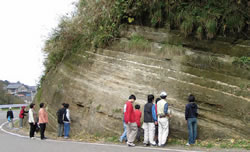
The beautiful striations along the cliffs here were formed 3 million years ago at the bottom of the Fossa Magna Sea. Large underwater landslides caused would cover the seabed with a layer of sand, which would then become covered with mud, only to become covered with sand again after the next landslide. Over the years, these hardened into sandstone and mudstone, creating distinctive diagonal stripes along the cliff.
 Tsutsuishi Station
Tsutsuishi Station

This unusually built station has its platform located 20m below sea level, in the middle of an 11km long tunnel. The station building is located on a hillside, equating to a 40m difference in height between station and platform.
Visitors to the station must walk 280 steps between the ticket gate and the platform. The station is popular among train enthusiasts as it is one of the few examples of stations built within tunnels. Especially popular is experiencing the rush of wind that is forced through the tunnel by passing trains.
Note: Flash photography on the platform can distract drivers and is strictly prohibited. Please follow the guidance of station staff at all times.
 Weeping Cherry Tree Road
Weeping Cherry Tree Road
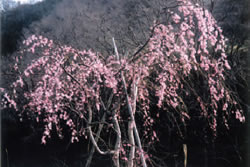
Gorgeously decorated with cherry trees of various varieties, including many weeping cherries, this road connects Tokuai village with the sea. With its beautiful cherry trees, terraced rice fields, and pastoral scenery, it was a natural choice as one of the Scenic Byways of Japan, as designated by the Ministry of Land, Infrastructure, Transport, and Tourism. The various cherry varieties bloom at different times, keeping the village flush with pink and white blossoms from April through May.
The road starts at Hamatokuai village, about 30 minutes by foot from Tsutsuishi Station. It passes through the village of Tokuai, following Prefectural Route 431 and at Senno village it loops back to Tsutsuishi Station. From the station, the loop course is about km long, taking 2 to 2.5 hours to walk. Being a rural road without footpaths, hikers are asked to be mindful and yield to automobile traffic.
 Tsutsuishi Fishing Port
Tsutsuishi Fishing Port
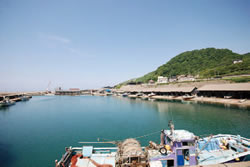
The fishing industry has long flourished in the Tsutsuishi region, and today the Tsutsuishi Fishing Port remains an important source of maritime produce. A large variety of fish are caught here, but the main catches include sea bream, black rockfish, and deep-sea smelt. Also caught here are some of Itoigawa's specialties, like Nanban Shrimp (Alaska pink shrimp) and Benizuwai Crab (red snow crab).
Houses of Tsutsuishi

Tsutsuishi is one of the many fishing villages along the coast of Itoigawa. An old village, it is characterized by its location, sandwiched between the mountains, and the sea, requiring the residents to employ an unusual architectural style— the houses are built narrowly but tall, usually 3 stories in height with only a room or two per floor. To further save space, most houses share a wall with their neighbor, a feature which reinforces the community-oriented lifestyle still prevalent in rural Japan.
The houses within this village are private residences, so please be respectful when photographing.
Former Site of Tokuai Castle
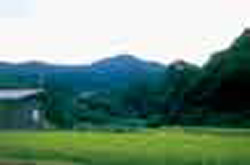
Built at a height of 316m atop a small mountain, Tokuai Castle was the main keep of Ohmine Fort to the east and Tsutsushi Castle to the northwest. During the Warring States Period, when Japan was mired in 200 years of near constant civil war, this group of fortifications were a vital line of defense. They were maintained by the Murakami family, close allies of the Uesugi family which ruled Echigo Province (now Niigata Prefecture).
Taitsuri-mai
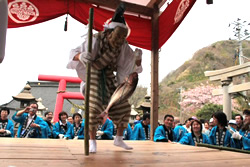
While many of the fishing villages hold similar festivals where fisherman pray for bountiful catches, Tsutsuishi's Taitsuri-mai, or "Sea Bream Fisher's Dance," is unique. Here, the performer dances about the stage with an actual fish, usually a larger fish like a mackerel or amberjack, to the delight of festivalgoers and the gods.
Route to Tsutsuishi Hamatokuai Geosite
Destination:


